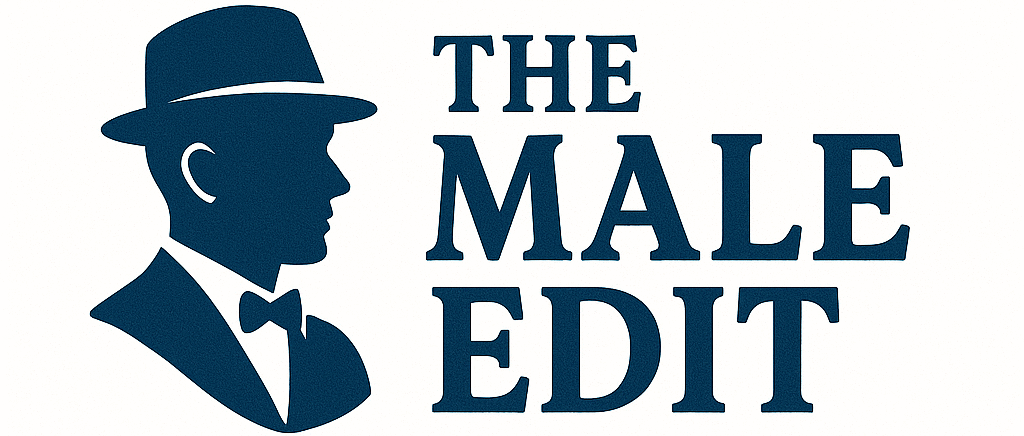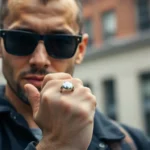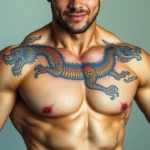We’ve all been there – standing in front of our closet wondering what exactly “business casual” means and how to nail that perfect professional look without overdressing. The modern workplace has evolved dramatically and so have the dress codes that come with it.
Business casual for men isn’t just about throwing on khakis and calling it a day. It’s about striking the right balance between professional polish and comfortable practicality. We’re talking about creating outfits that command respect in meetings while keeping you comfortable during those long workdays.
Whether you’re starting a new job or simply refreshing your work wardrobe we’ll show you exactly how to build versatile business casual outfits that work for any office environment. From essential pieces every man should own to styling tips that’ll have you looking sharp and confident we’ve got everything you need to master the art of professional dressing.
Essential Wardrobe Foundations for Business Casual Success
Building a solid business casual wardrobe starts with investing in key pieces that work together seamlessly. These foundational items create the backbone of countless outfit combinations for professional settings.
Quality Dress Shirts and Polo Shirts
Dress shirts form the cornerstone of any business casual wardrobe. We recommend starting with classic white and light blue Oxford shirts, as they pair effortlessly with any bottom and blazer combination. Invest in at least three to five quality dress shirts in neutral colors like white, light blue, and subtle patterns such as small checks or thin stripes.
Polo shirts offer a more relaxed alternative while maintaining professionalism. Choose solid colors in navy, white, gray, and burgundy for maximum versatility. Look for polos made from pique cotton or performance fabrics that resist wrinkles and maintain their shape throughout the workday.
Fit matters more than brand when selecting shirts. Ensure the collar sits comfortably around your neck without gapping, and the shoulder seams align with your natural shoulder line. Sleeve length should end at your wrist bone, allowing about a quarter inch of shirt cuff to show when wearing a blazer.
Well-Fitted Chinos and Dress Pants
Chinos represent the perfect middle ground between casual jeans and formal dress pants. Navy, khaki, gray, and olive chinos work in most professional environments and coordinate with various shirt and blazer combinations. Aim for a slim or straight fit that flatters your body type without being too tight or baggy.
Dress pants elevate your business casual look for important meetings or client presentations. Wool or wool blend trousers in charcoal, navy, and medium gray provide sophisticated options that pair beautifully with dress shirts and blazers. These pants should have a clean, customized appearance with minimal break at the ankle.
Proper fit transforms average pants into wardrobe staples. The waistband should sit comfortably at your natural waist without requiring a belt to stay in place. Length should create a slight break on your shoe, and the seat should provide enough room for comfortable movement without excess fabric.
Versatile Blazers and Sport Coats
Blazers instantly elevate any business casual outfit from ordinary to polished. A navy blazer serves as the most versatile piece in your wardrobe, working with jeans for casual Fridays or dress pants for client meetings. Gray and charcoal blazers offer additional styling options for different occasions and seasons.
Sport coats with subtle patterns add visual interest to your professional wardrobe. Tweed, herringbone, or small windowpane patterns provide texture and sophistication while remaining appropriate for business environments. These pieces work exceptionally well during fall and winter months.
Unstructured blazers offer comfort without sacrificing style. Look for blazers with minimal padding and soft construction that allow for easier movement throughout the day. Cotton, linen, or cotton blend blazers work well in warmer climates and provide a more relaxed professional appearance.
Smart Footwear Options That Strike the Perfect Balance
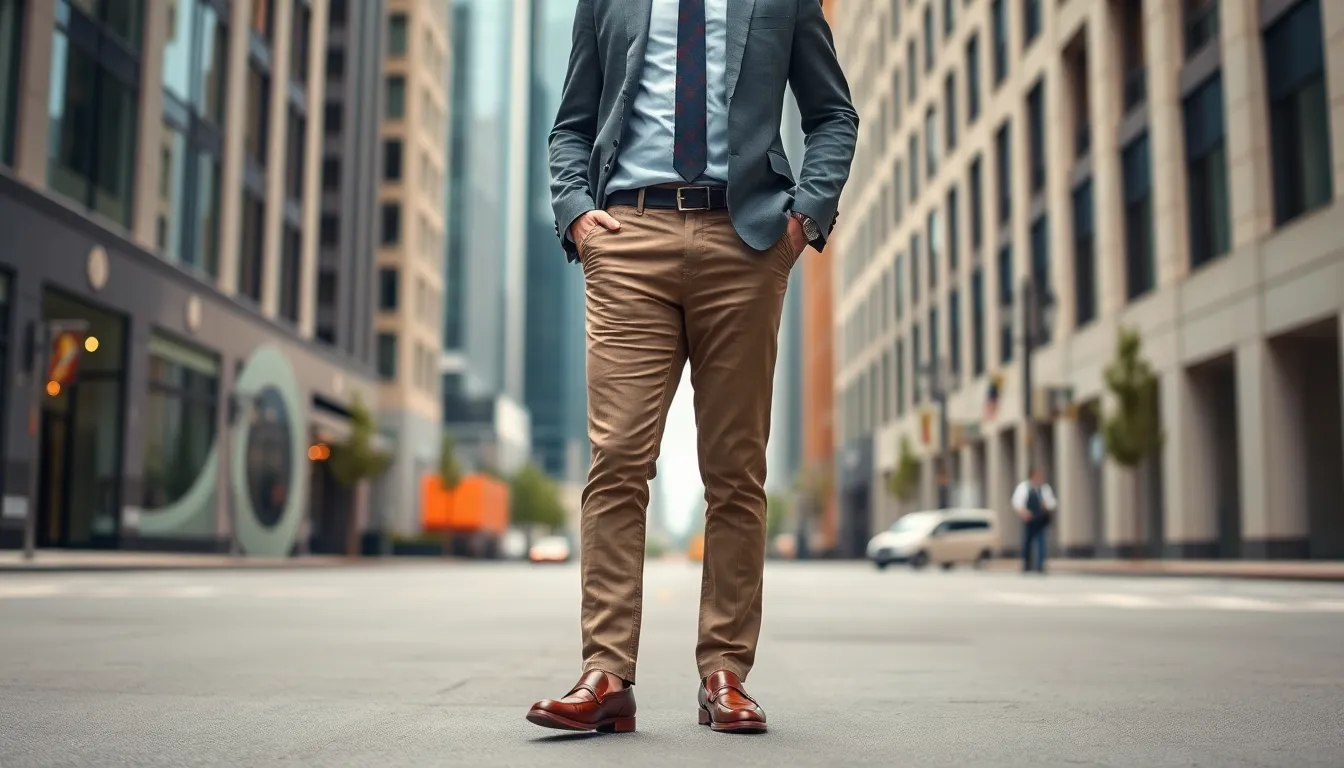
Finding the right shoes completes your business casual look while ensuring comfort throughout long workdays. We’ve identified three essential footwear categories that seamlessly blend professionalism with relaxed elegance.
Leather Loafers and Driving Shoes
Leather loafers represent the cornerstone of smart business casual footwear. These slip-on shoes add sophistication while maintaining a casual vibe that works perfectly with chinos and dress pants. We recommend investing in quality leather options in brown, black, or burgundy to match various outfit combinations.
Traditional penny loafers offer timeless appeal and pair beautifully with both casual blazers and polo shirts. Tassel loafers provide a slightly more formal option that elevates your overall appearance. Driving shoes bring Italian-inspired elegance to your wardrobe with their distinctive sole design and premium leather construction.
Quality matters significantly when choosing loafers since they’ll become daily essentials in your business casual rotation. Proper leather care extends their lifespan while maintaining the polished appearance your professional image requires.
Clean Sneakers and Casual Oxfords
Clean sneakers have earned their place in modern business casual wardrobes, particularly in industries that embrace more relaxed dress codes. We suggest white leather sneakers or minimal canvas options that complement chinos and dark wash jeans without appearing too sporty.
Casual oxfords bridge the gap between formal dress shoes and relaxed footwear options. These lace-up shoes offer more refinement than sneakers while remaining comfortable for all-day wear. Oxford styles in brown or tan leather work exceptionally well with business casual outfits.
Maintenance plays a crucial role in keeping both sneakers and casual oxfords workplace appropriate. Regular cleaning ensures your footwear maintains the professional standard your business casual attire demands.
Dress Boots for Added Sophistication
Dress boots elevate business casual outfits while providing additional sophistication, especially in colder climates or more formal business casual settings. Chelsea boots offer sleek silhouettes that work seamlessly with both chinos and dress pants throughout various seasons.
Chukka boots provide versatile styling options with their ankle-high design and classic desert boot aesthetic. These suede or leather options complement blazers beautifully while maintaining the relaxed professionalism business casual requires. Wingtip boots combine traditional brogue detailing with modern boot construction for enhanced visual interest.
Weather considerations make dress boots particularly valuable during fall and winter months when your business casual wardrobe needs reliable footwear options. Quality construction ensures these boots withstand daily wear while maintaining their sophisticated appearance.
Mastering the Art of Business Casual Layering
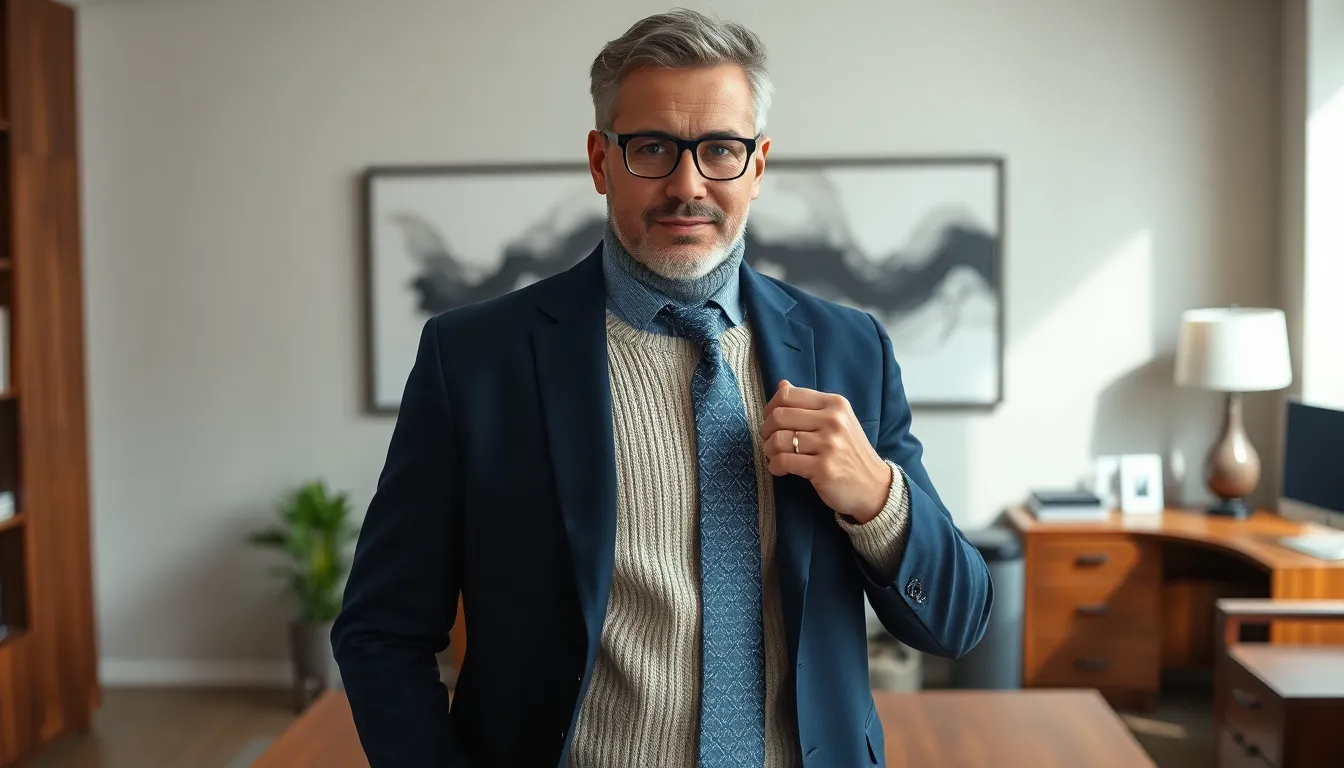
Layering transforms basic business casual pieces into sophisticated outfits that adapt to changing office temperatures and professional demands. We’ll show you how strategic layering creates depth and visual interest while maintaining the polished appearance your workplace requires.
Sweaters and Cardigans for Professional Polish
Lightweight sweaters serve as versatile layering pieces that bridge the gap between formal and casual workplace attire. We recommend thin merino wool or fine cotton options in neutral colors like navy, gray, and cream that won’t add bulk to your silhouette. V-neck sweaters work exceptionally well over button-down shirts, allowing the collar to peek through for a refined appearance.
Cardigans offer unmatched versatility for business casual environments where you need to adjust your formality level throughout the day. Choose cardigans in solid colors that complement your existing wardrobe, focusing on quality fabrics that maintain their shape after multiple wears. Button-front styles provide more structure than pullover options, making them ideal for meetings or client interactions.
Quality matters significantly when selecting sweaters for professional settings, as cheaper materials often pill or lose their shape quickly. We suggest investing in pieces from reputable brands that use natural fibers, as these maintain their professional appearance longer and provide better temperature regulation throughout your workday.
Lightweight Jackets and Vests
Blazers instantly elevate any business casual outfit, providing structure and sophistication that separates professional attire from weekend wear. Navy blazers offer the most versatility, pairing seamlessly with gray chinos, white shirts, and brown leather accessories. Sports coats with subtle textures or patterns add visual interest without compromising professionalism.
Unstructured blazers provide comfort without sacrificing style, making them perfect for long office days or travel. These softer-shouldered options move with your body naturally while maintaining the polished appearance that business casual demands. Light colors like beige or light gray work particularly well in warmer months or casual Friday environments.
Vests create an interesting middle ground between fully casual and traditionally formal business attire. Wear them over dress shirts for added warmth and style without the weight of a full jacket. Choose vests in complementary colors to your pants, ensuring they enhance rather than compete with your overall outfit composition.
Strategic Use of Ties and Pocket Squares
Ties remain optional in most business casual settings, but they provide valuable flexibility for varying formality requirements throughout your week. Keep a selection of understated ties in classic patterns like stripes, dots, or subtle plaids that coordinate with your existing shirt collection. Narrow ties often work better with business casual outfits than traditional wide versions.
Consider your workplace culture carefully when deciding whether to incorporate ties into your regular rotation. Some environments appreciate the extra formality for client meetings or presentations, while others view ties as unnecessarily formal for daily operations.
Pocket squares offer a subtle way to add personality and attention to detail without overwhelming your professional appearance. Choose squares in solid colors or simple patterns that complement your blazer and shirt combination. Fold them simply rather than using elaborate styles that might appear too fashion-forward for conservative business environments.
The key lies in using these accessories strategically rather than as daily requirements, allowing you to adjust your formality level based on your schedule and professional obligations.
Color Coordination and Pattern Mixing Guidelines

Mastering color coordination and pattern mixing transforms your business casual wardrobe from basic to brilliant. We’ll guide you through the fundamental principles that help create cohesive, professional outfits that command respect in any workplace setting.
Safe Color Palettes for Work Environments
Neutral tones form the foundation of successful business casual wardrobes. Navy, beige, grey, and stone serve as universally safe choices that pair seamlessly with most colors and patterns. These versatile shades create a professional base that never goes out of style.
Building your palette around these core neutrals ensures versatility and sophistication. Charcoal and forest green work exceptionally well during fall and winter months, while lighter alternatives like soft blues, sage, and stone become perfect choices for spring and summer seasons.
Strategic color selection minimizes wardrobe complexity while maximizing outfit potential. Navy blazers pair effortlessly with khaki chinos, while grey trousers complement virtually any shirt color. Stone colored pieces bridge the gap between formal and casual, making them ideal for transitional workplace environments.
Incorporating Subtle Patterns and Textures
Subtle patterns add visual interest without compromising professionalism. Microchecks, narrow stripes, and small scale plaids create sophisticated variety while maintaining workplace appropriateness. These understated designs work particularly well in dress shirts and casual button downs.
Textural elements enhance outfits through visual and tactile appeal. Wool, flannel, and fine knits provide depth during colder months, while cotton and linen fabrics offer breathability and refinement in warmer weather. These material choices create natural sophistication without requiring bold colors or patterns.
Avoiding overwhelming combinations keeps your look polished and intentional. Pair one patterned piece with solid colored items to maintain balance. A striped shirt looks sharp with solid chinos, while a textured blazer pairs beautifully with a plain dress shirt underneath.
Seasonal Color Adjustments
Spring and summer wardrobes benefit from lighter, more vibrant color choices. Pastel tones and bright accents work well with breathable fabrics like cotton and linen. These seasonal shifts keep your business casual looks fresh and weather appropriate.
Fall and winter months call for richer, deeper color palettes. Darker tones like burgundy, forest green, and charcoal create warmth and sophistication. Layered textures through wool sweaters, flannel shirts, and knit cardigans add both visual interest and practical comfort.
Seasonal transitions require thoughtful color planning to maintain consistency. A linen blazer bridges summer formality with comfort, while a wool cardigan provides autumn sophistication. These transitional pieces ensure your wardrobe adapts smoothly to changing weather conditions.
Accessory Selection for the Modern Professional
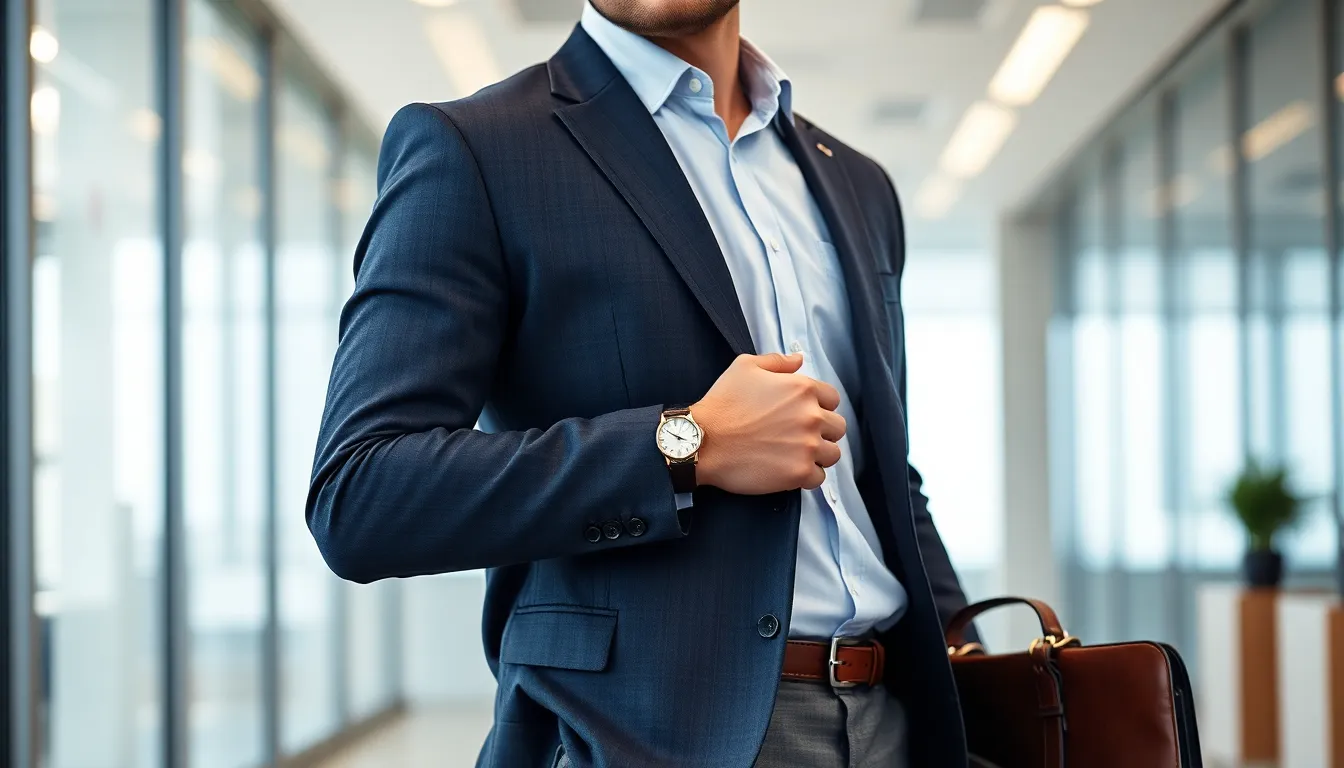
We complete our business casual foundation by carefully selecting accessories that reinforce professionalism without overwhelming the overall look. Strategic accessory choices can elevate any outfit while maintaining the balanced aesthetic we’ve been building.
Watches and Jewelry That Enhance Your Look
Watches serve as the centerpiece of business casual accessorizing, functioning as both practical timepieces and style statements that signal attention to detail. We recommend leather or metal band watches with neutral or classic dials that pair seamlessly with most outfit combinations. Dress watches with minimalist designs work exceptionally well in professional settings, while avoiding overly sporty or flashy timepieces maintains the sophisticated balance we’re aiming for.
Jewelry should remain understated and purposeful in business casual environments. We suggest limiting pieces to a single bracelet, subtle cufflinks for dress shirts, or a simple ring to add personal flair without distraction. Coordinating metal finishes across all jewelry pieces creates a cohesive look, whether you choose silver, gold, or rose gold tones throughout your accessories.
Quality over quantity defines our approach to business casual jewelry, ensuring each piece serves a exact purpose in improving your professional image. We avoid bold or oversized accessories that compete with the clean lines of well-fitted clothing, instead focusing on pieces that complement rather than dominate the overall ensemble.
Belts and Leather Goods Coordination
Belt selection follows a fundamental matching principle where leather colors coordinate directly with shoe choices—brown belts with brown shoes, black belts with black footwear. We choose belts with simple, refined buckles that avoid flashy hardware or oversized designs that might detract from the polished aesthetic we’re creating.
Leather goods coordination extends beyond just belts to include wallets, cardholders, and other accessories that should harmonize with both belt and shoe colors. We maintain consistency across all leather elements to ensure a cohesive style that demonstrates attention to detail and professional polish.
Quality leather goods investment pays dividends in both durability and appearance over time. We select pieces that will age gracefully and maintain their professional appearance through regular use, focusing on classic designs that won’t become outdated as fashion trends change.
Bags and Briefcases for Every Occasion
Structured briefcases and messenger bags represent our go-to choices for formal office environments and client meetings, with leather or high-quality fabric options in neutral colors like black, brown, or navy providing maximum versatility. We choose slim profiles that maintain a professional silhouette without appearing bulky or casual.
Crossbody bags and compact backpacks suit more relaxed business casual settings where mobility and comfort take priority. We select designs with clean lines and minimal branding that still maintain professional credibility while offering practical functionality for daily commutes and office movement.
Classic satchels and attaché cases serve exact professional scenarios where traditional formality remains important. We recommend these options for industries or situations requiring a more conservative approach to business casual dressing, ensuring our bag choice aligns with the overall professional context we’re handling.
Industry-Specific Business Casual Considerations
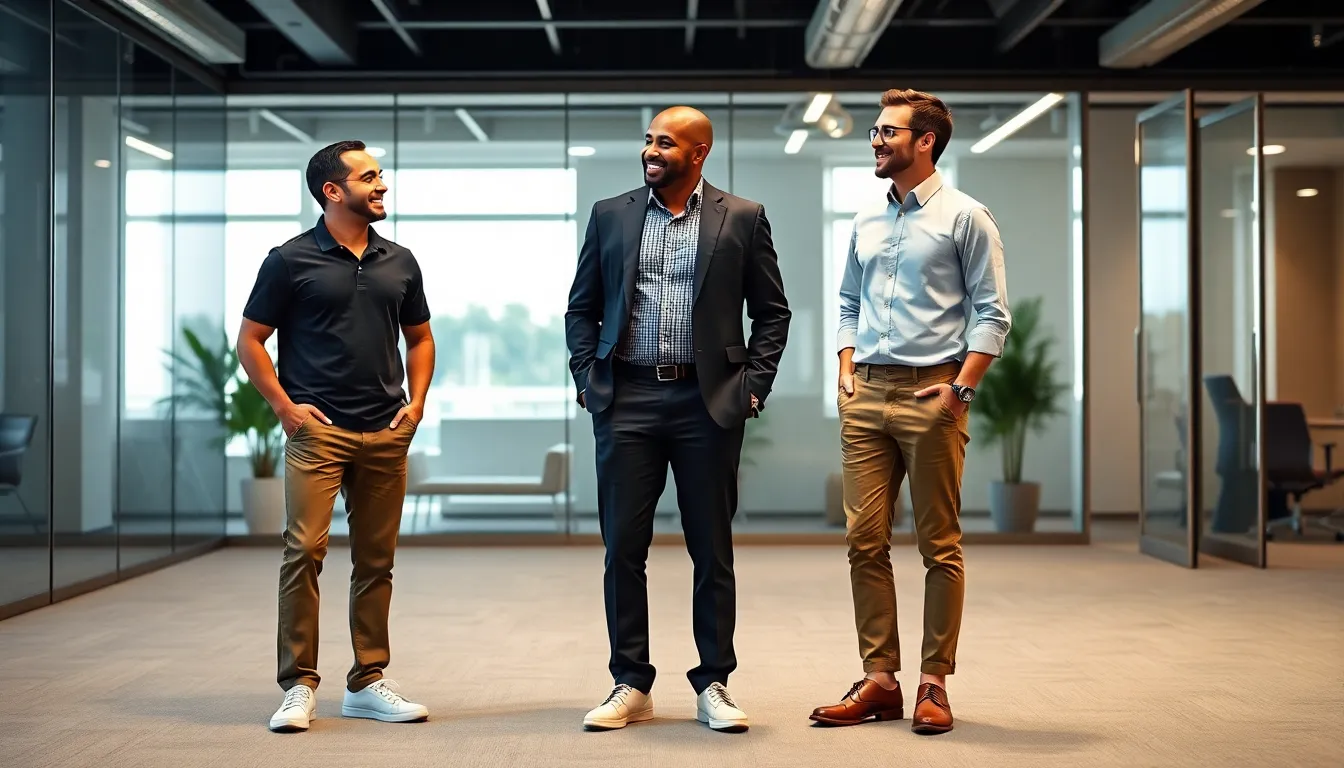
Different industries interpret business casual through their own cultural lens, making it essential to understand your workplace’s exact expectations. We’ll explore how tech companies, traditional corporations, and client-facing roles each approach professional casual attire.
Tech and Creative Field Variations
Tech and creative industries embrace the most relaxed interpretation of business casual dress codes. Polo shirts and button-down shirts (often worn untucked) form the foundation of acceptable workplace attire in these environments. Chinos paired with dark wash jeans create versatile bottom options that balance professionalism with comfort.
Outerwear choices expand to include cardigans and quarter-zip sweaters, allowing for personal expression while maintaining a polished appearance. Footwear flexibility reaches its peak in these sectors, where clean sneakers sit comfortably alongside traditional loafers. Minimal branding becomes the guiding principle, ensuring your clothing doesn’t distract from your professional contributions.
Athletic wear and graphic tees remain off-limits, even in the most casual tech environments. Companies in these industries prioritize comfort and individuality while avoiding overly casual pieces that might undermine professional credibility.
Traditional Corporate Environment Guidelines
Traditional corporate settings maintain stricter business casual standards that lean toward formal presentation. Blazers and sports coats become essential pieces, often worn over solid or subtly patterned button-down shirts. Dress pants such as chinos or wool trousers replace the relaxed jean options found in creative industries.
Leather shoes dominate footwear choices, with oxfords, loafers, and Chelsea boots representing the acceptable range. Dress shirts typically require tucking in, though jackets may be worn open or removed when working indoors. Ties remain optional unless company policy specifically requires them for certain meetings or events.
Professional polish takes precedence over comfort in these environments, where conservative styling choices signal respect for established corporate culture.
Client-Facing Role Requirements
Client-facing positions demand the highest level of business casual presentation, as your appearance directly represents your company’s brand. Blazers become nearly mandatory, paired with pressed dress shirts that project competence and attention to detail. Chino or wool trousers maintain their professional edge when properly fitted and pressed.
Polished leather shoes are non-negotiable in these roles, with oxfords and Chelsea boots providing the most credible options. Conservative patterns and colors support your professional image, avoiding any elements that might distract from your message or expertise.
Grooming standards intensify in client-facing positions, where accessories like quality belts and watches contribute to your overall professional presentation. Companies typically discourage jeans unless explicitly permitted by policy, understanding that client perceptions often influence business outcomes.
| Industry/Role | Top | Bottom | Footwear | Notes |
|---|---|---|---|---|
| Tech/Creative | Polo, Button-down, Cardigan | Chinos, Jeans | Sneakers, Loafers | Minimal branding, comfort |
| Traditional Corporate | Button-down, Blazer | Chinos, Wool Trousers | Oxfords, Loafers | Jacket optional, tucked in |
| Client-Facing | Button-down, Blazer | Chinos, Wool Trousers | Oxfords, Chelsea Boots | Conservative, polished |
Common Business Casual Mistakes to Avoid

Even with the best intentions, we often see professionals stumble into common business casual traps that can undermine their polished appearance. Understanding these pitfalls helps us maintain that perfect balance between professional and approachable.
Overdressing and Underdressing Pitfalls
Overdressing creates an awkward disconnect in business casual environments, making you appear out of touch with workplace culture. Wearing full suits with ties when colleagues sport blazers and chinos signals that you haven’t grasped the dress code nuances. We recommend sticking to separates like blazers paired with dress pants and leaving ties at home unless exact occasions demand them.
Underdressing poses an equally problematic challenge, with jeans and T-shirts typically falling short of business casual standards. Sneakers might seem comfortable, but they rarely meet professional expectations unless your workplace culture explicitly embraces them. Smart professionals choose chinos over jeans, button-down shirts instead of casual tees, and polished leather shoes rather than athletic footwear.
Finding the sweet spot requires observing your colleagues and understanding company guidelines to ensure your outfits align with expected standards. Business casual environments vary significantly, so what works at a tech startup might seem too casual for a financial services firm.
Fit and Grooming Issues
Poorly fitted clothing destroys even the most expensive business casual pieces, making you look unprofessional regardless of brand names or price tags. Clothes that are too tight restrict movement and create unflattering silhouettes, while oversized garments make you appear sloppy and careless. Tailoring becomes essential for achieving that crisp, put-together appearance that commands respect in professional settings.
Grooming lapses sabotage your carefully planned business casual outfits faster than any fashion mistake. Unkempt hair, untrimmed nails, and wrinkled clothing send signals that you don’t pay attention to details. We’ve learned that maintaining neat grooming standards amplifies the impact of well-chosen business casual pieces.
Investment in fit pays dividends across your entire wardrobe, transforming basic pieces into sophisticated professional attire. Regular dry cleaning and proper garment care preserve the crisp appearance that makes business casual work in professional environments.
Inappropriate Fabric and Style Choices
Loud patterns overwhelm business casual outfits and draw attention away from your professional competence. Bright Hawaiian prints, oversized plaids, and flashy graphics belong in casual weekend settings rather than workplace environments. Structured materials and classic patterns create refined looks that enhance rather than distract from your professional presence.
Casual fabrics like fleece, ripped denim, and athletic wear materials signal that you’ve misunderstood business casual expectations. These textures communicate relaxation rather than professionalism, undermining your credibility with colleagues and clients. Quality fabrics like cotton Oxford, wool blends, and structured knits maintain appropriate formality while offering comfort throughout long workdays.
Inappropriate styles including sportswear elements and overly trendy pieces create confusion about your professional judgment. Business casual requires clothing that projects competence and reliability rather than fashion-forward statements or athletic functionality.
Budget-Friendly Shopping Strategies for Professional Attire

Creating a professional business casual wardrobe doesn’t require very costly. Smart shopping strategies help us build a polished collection while staying within budget.
Building a Capsule Wardrobe Approach
Start with essential pieces that work across multiple outfits and occasions. A capsule wardrobe for business casual men should include three Oxford cloth button-down shirts, two pairs of chinos in versatile colors, and one quality blazer that elevates any ensemble.
Focus on neutral colors like navy, grey, and beige to maximize mixing and matching potential. These colors form the foundation of countless outfit combinations and ensure every piece works harmoniously together.
Invest in versatile layering pieces such as lightweight sweaters and unstructured blazers. Layering options like these transform basic outfits into sophisticated looks while adapting to changing office temperatures throughout the day.
Choose quality basics over quantity when building your initial collection. Starting with fewer high-quality pieces creates more outfit possibilities than filling your closet with many mediocre items that don’t coordinate well.
Best Places to Shop for Quality Pieces
Nordstrom offers comprehensive selections of business casual attire with frequent sales and promotions that make professional pieces more accessible. Their wide range of brands ensures options for every budget and style preference.
Lululemon provides comfortable work clothes that blend professional appearance with all-day wearability. Their innovative fabrics and modern cuts work perfectly for today’s flexible office environments.
Hockerty delivers customizable suits and blazers that ensure perfect fit without the premium price of traditional tailoring. Custom options help us achieve that polished look while staying within reasonable budget constraints.
Thrift stores and online platforms offer gently used professional attire at fraction of retail prices. These sources often carry high-quality pieces from premium brands that would otherwise exceed our budget limitations.
Investment vs. Trendy Item Decisions
Prioritize investment pieces for essential wardrobe foundations like quality blazers, dress shoes, and well-fitted chinos. These core items form the backbone of multiple outfits and justify higher upfront costs through extended wear and versatility.
Save money on trendy accessories and seasonal pieces that change frequently. Items like pocket squares, seasonal colors, and fashion-forward details can come from budget-friendly sources without compromising overall appearance.
Focus quality spending on items that impact fit such as blazers, dress pants, and leather goods. Proper fit dramatically affects how professional we appear, making these pieces worthy of larger budget allocations.
Consider cost per wear when making purchase decisions between expensive and affordable options. A $200 blazer worn twice weekly costs less per use than a $50 blazer that needs replacement after six months of regular wear.
Conclusion
Mastering business casual attire isn’t about following rigid rules—it’s about understanding your workplace culture and building a wardrobe that works for you. We’ve shown you how strategic investments in quality basics can create countless professional looks that keep you comfortable and confident throughout your workday.
Remember that fit and attention to detail make all the difference. Whether you’re mixing patterns or coordinating accessories your goal should be looking polished without appearing overdressed for your environment.
With these foundations in place you’re equipped to navigate any business casual situation. Start with the essentials we’ve outlined and gradually expand your wardrobe as you better understand your exact workplace needs. Your professional image will thank you for the thoughtful approach.
Frequently Asked Questions
What exactly is business casual attire for men?
Business casual is a professional dress code that balances formality with comfort. It typically includes dress shirts or polos, well-fitted chinos or dress pants, and leather shoes or clean sneakers, often paired with blazers or sport coats. The goal is to look polished and professional while maintaining comfort for long workdays.
What are the essential pieces for a business casual wardrobe?
The foundation includes quality dress shirts (white and light blue Oxford), solid-colored polos, well-fitted chinos in navy and khaki, dress pants in charcoal and navy, a versatile navy blazer, and quality leather loafers. These pieces can be mixed and matched to create multiple professional outfits.
What footwear works best for business casual?
Three key categories work well: leather loafers and driving shoes for a polished look, clean sneakers (white leather or minimal canvas) for relaxed environments, and dress boots like Chelsea or Chukka styles for added sophistication. Quality and maintenance are crucial for maintaining a professional appearance.
How should I approach layering in business casual outfits?
Start with lightweight sweaters and cardigans as versatile base layers. Add blazers or unstructured jackets to elevate your look, and consider vests for a stylish middle ground. Focus on quality materials and ensure layers work together cohesively while adapting to changing office temperatures throughout the day.
What colors work best for business casual attire?
Stick to neutral tones like navy, beige, grey, and stone as your foundation. Adjust seasonally with lighter, vibrant colors for spring/summer and richer tones for fall/winter. Incorporate subtle patterns like microchecks and varied textures to add visual interest while maintaining professionalism.
How does business casual vary across different industries?
Tech and creative industries favor relaxed approaches with polo shirts and chinos, sometimes allowing dark jeans. Traditional corporate environments require stricter standards with blazers and dress pants. Client-facing roles demand the highest presentation level with polished attire and grooming. Always understand your workplace’s specific expectations.
What are common business casual mistakes to avoid?
Avoid overdressing with full suits in casual environments or underdressing with jeans and t-shirts. Ensure proper fit in all clothing, maintain good grooming standards, and avoid loud patterns or overly casual materials. Poor fit and unkempt appearance can undermine even quality pieces.
How can I build a business casual wardrobe on a budget?
Start with a capsule wardrobe approach: three Oxford shirts, two pairs of chinos, and one quality blazer in neutral colors. Invest in versatile basics over quantity, shop at stores like Nordstrom, Lululemon, or thrift shops, and calculate cost-per-wear to make smart investment decisions.
